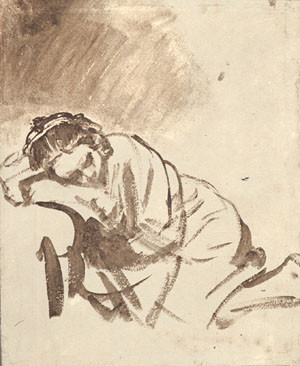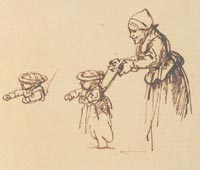Rembrandt Drawings
text from:
Drawings of Rembrandt: With a Selection
of Drawings by his Pupils and Followers
Seymour Slive
London, 1965
Thanks to the concerted efforts of devoted collectors, museum curators, and scholars, about 1,400 drawings by Rembrandt have been preserved and carefully catalogued. This number takes on astronomical proportions when we consider that today not a single drawing can be ascribed with certainty to Frans Hals or Vermeer. Probably neither Hals nor Vermeer was as prolific a draughtsman as Rembrandt-few artists were - but it is impossible to believe that Hals and Vermeer never made drawings. One day some may be found. Meanwhile the lacunae in their work can be attributed to the notoriously high mortality of old master drawings.

A Woman Sleeping
c. 1655
The British Museum, London
If time has successfully erased every trace of drawings by Hals and Vermeer, what has it done to Rembrandt's production as a draughtsman? To be sure, Rembrandt always enjoyed a much higher reputation than his two great contemporaries, and even when he was not esteemed in many circles, his works were generally recognized and discussed. Frans Hals and Vermeer were virtually forgotten during the eighteenth and part of the nineteenth centuries; this helps explain the disappearance of their drawings. However, we also know that the merits of a slight sketch, even by a master of Rembrandt's stature, can escape the untrained ere. The precious drawings owned by a collector are not necessarily the prized possessions of his heirs. Rembrandt's practice of drawing on anything at hand-sketches by him have been discovered on bills, printed pages, and on the backs of funeral announcements-does not enhance the importance of his drawings to the casual onlooker. How much has been lost as a result of negligence, ignorance, fife, shipwreck, or because of what insurance companies categorize as "acts of God"? We can only guess. Fifty per cent is a conservative estimate. By any count his output as a draughtsman was prodigious. He must have made drawings as readily as he breathed.
Like other artists he drew preparatory studies far his paintings and prints, but he did not make many drawings of this type. Those executed as finished works, complete in themselves, are even rarer. Most of Rembrandt's drawings were made to satisfy an insatiable urge to record what he saw with his inner, as well as his outer ere. Master draughtsman from Durer to Picasso have had the same compulsion, but none of them has responded to it as frequently and consistently as Rembrandt did.
The majority of his drawings can be compared to the notes, ideas and aphorisms jotted down by a great writer. Sometimes they are worked aver and polished. They may inspire or find a place in more ambitious works. It is not necessary, however, to see their relation to larger projects in order to enjoy their quality or grasp their importance. Indeed their spontaneity and freshness have a direct appeal sometimes missing from more elaborately executed pieces.

An Old Woman Holding
a Child in Leading Strings
c. 1645
160 x 1654 mm.
Nationalmuseum, Stockholm
The selection reproduced in these volumes gives an excellent idea of Rembrandt's unmatched range, depth, and human sympathy. It includes self-portraits and portraits; sketches of the humdrum activities on Amsterdam's busy streets; beggars and quacks, children at play, women gossiping, or people merely watching the passing scene; studies of Jewish types and Orientals; drawings of nudes, birds, domestic animals and captive wild beasts; copies of famous works of art, rare medals and exotic Moghul miniatures; views of towns and architectural monuments; studies of the landscape around Amsterdam and of the spacious Dutch countryside; drawings of episodes from classical mythology, ancient history, and, above all, the Bible. The largest group depicts Biblical themes.
Although it was Rembrandt's practice to sign and date his paintings and etchings, he hardly ever inscribed his name on his drawings. Only about two dozen bear his signature. In the final analysis most drawings must be ascribed to him on the basis of conclusions about their style. The general agreement of generation after generation of Rembrandt specialists about the authenticity of the bulk of his drawings, as well as about the main line of his development from his first bold efforts in Leiden to the majestic works of his last years, is one of the best proofs of the validity of stylistic criticism.
Some of Rembrandt's rare signed drawings were made expressly as contributions to the albums of friends, for example, the drawings of Homer Reciting Verses and Minerva in Her Study done for the Album Amicorum entitled "Pandora" which belonged to his friend and patron Jan Six. A few others may have been designed as presentation sheets. However, most of them needed no signature. They were made for Rembrandt's private use, not for the public or posterity. He saved and stored them in a systematic way. The inventory made of his effects in 1656, when he was declared insolvent and his property was sold at auction to pay his debts, reveals that he preserved them in bound books between blank pages, a method still favored by a few sensitive collectors. Twenty-four books of his drawings and two parcels of sketches are listed in the 1656 inventory. Some of the books are specifically described as containing drawings devoted to a single subject: nudes, figure studies, landscapes, animals, and so on. There is one significant exception. It is listed as "A book bound in black leather with Rembrandt's best sketches" (een boeck inswart leer gebonden met de beste schetsen van Rembrant).
The buyers of Rembrandt's drawings at the 1656 auction remain anonymous, but one of them may very well have been Jan van de Cappelle, the fine marine painter who was also a wealthy and avid collector. An inventory compiled of van de Cappelle's possessions after his death in 1679 lists, among other treasures, about seven thousand drawings; approximately five hundred of these were by Rembrandt-he owned almost as many original Rembrandts as are reproduced in this selection of the master's drawings. One of the portfolios in van de Cappelle's estate is described as containing one hundred and thirty-five drawings by Rembrandt of the fife of women and children. Today about sixty " Rembrandt drawings scattered in various collections fit this classification-a clue which helps estimate how many drawings have been lost.
From Van de Cappelle's time until around the middle of the nineteenth century there was always a distinguished, if rather small, group of connoisseurs who treasured Rembrandt's drawings. As early as 1699 the French collector and critic, Roger de Piles, writes that Rembrandt's infinite number of drawn pensées are not less pungent or pointed than those by the best painters and, de Piles adds, he owns a great number of sketches which can conclusively prove that his assertion is impartial. In 1725 Jonathan Richardson, the English painter, collector, and critic, claimed that the touching solemnity of Rembrandt's drawing in his possession of St. Peter's Prayer Before the Raising of Tabitha gives it "the utmost excellency that I think I ever saw, or can conceive is possible to be imagined." Similar quotations can be culled from a few other eighteenth-century and early ninetenth-century connoisseurs, but on the whole this international group expressed their esteem by acquiring Rembrandt drawings, net by writing about them. Pierre Crozat, the inspired eighteenth-century Parisian collector who purchased drawings and prints on a scale which has never been surpassed, owned three hundred and fifty-one Rembrandt drawings.
REMBRANDT DRAWING AND ETCHINGS RESOURCES
- Benesch, O., The Drawings of Rembrandt, 6 vols. 2nd ed. Phaidon, 1973
- Bevers, H., Shatborn, P. and Welzel, B. Rembrandt The Master and His Workshop: Drawings and Etchings, Yale University Press, 1991
- Bredius, A. (revised by H. Gerson). Rembrandt: The Complete Edition of the Paintings.,
- Brown, C., Kelch, J., and van Thiel, P. Rembrandt The Master and His Workshop:
Paintings, Yale University - Brown, C., Kelch, J., and van Thiel, P. Rembrandt The Master and His Workshop:
Paintings, Yale University - Hinterding, E., Luijten, G., Royalton-Kisch, M. Rembrandt the Printmaker, British Museum Press, 2000 (reprinted 2001)
- Royalton-Kisch, M.. Drawings by Rembrandt and his Circle in the British Museum. British
Museum Press, 1992
Van de Wetering, E. Rembrandt The Painter at Work, Amsterdam University Press, 1997
- White, C. and Boon, K. G. Hollstein's Dutch and Flemish Etchings [....], Vols xviii-xix:
Rembrandt van Rijn. Van Gendt, 1969
- White, C., Rembrandt as an Etcher, Yale University Press, 1999


